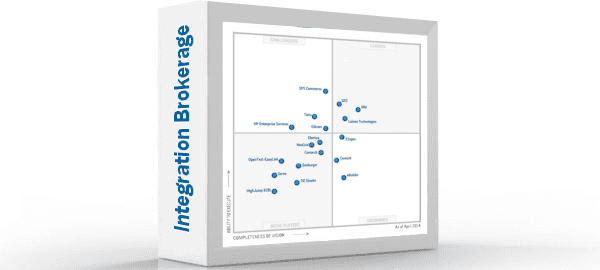Gartner Magic Quadrant for Integration Brokerage: Key Takeaways


Integration Brokerage is used primarily for the outsourcing of discrete data integration projects, typically those involving certain cloud and supply chain services. IB refers to one of the three primary cloud services roles and combines B2B integration infrastructures with people and processes to help businesses implement project management resources. In 2014, technology research giant Gartner unveiled one of their patented Magic Quadrants on Integration Brokerage, here’s a breakdown of that report:
Gartner defines the space: “[Integration Brokerage] is a revised and expanded definition for the market Gartner originally defined in 2004 as “Integration Service Providers.” Integration Brokerage is one of three primary cloud brokerage roles, the other two being aggregation brokerage and customization brokerage.”
Defining characteristics for providers in this space are scalable implementation of integration projects, managed service fulfillment capacity, a network of multilateral communication, and a multi-tenant cloud-based technology stack. Although Integration Brokerage competes with integration software (iPaaS), IB providers report worldwide growth year over year.
The study, which outlines 18 vendors, provides a comprehensive industry overview, highlighting where solutions in have been, where they’re headed, and what exactly each one offers. Gartner speaks to each solution’s strengths and weaknesses in an attempt to assist solution-seekers with their purchasing decisions. The included companies are grouped into four quadrants based on their ability to execute and on how complete their vision is. The names of each segment are as follows: Niche Players, Visionaries, Challengers, and Leaders.
In speaking to the current state of the market, Gartner notes: ” It is tempting to infer that the IB market is quite mature and the vendor landscape has become static, perhaps dominated by a few incumbent providers and little competition. However, on the contrary, the market is dynamic — it is still reinventing itself — fueled by changing integration requirements (e.g., cloud, mobile and IoT), sustained year-to-year investments in innovation, market growth and many acquisitions during the past few years.”
Compared to other Magic Quadrant reports, the vendors included in this diagram are all relatively close to one another. It’s easy to see from a quick glance that the Niche Players bracket is a crowded one, with only three companies having achieved Leadership status. In the other two quadrants, the vendors are all within close proximity to other brackets, meaning the separation amongst many of these vendors in terms of rankings are thin, according to Gartner.
Starting in the Leaders bracket, we see that IBM and GXS, now a wholly-owned subsidiary of OpenText, and a company well-known for operating the largest global B2B network, are jockeying for the top spot overall. Objects in the rearview mirror are closer than they appear, and Liaison Technologies, a fast-growing IT service provider with competency in large, custom integration projects is right behind both companies and is making a run at the top spot.
There are three challengers within striking distance of the coveted Leaders quadrant. The closest is Edicom, a prominent vendor of IB in Central Europe and Latin America, offering sophisticated tool-driven and real-time resource allocation for projects and efficiency operations. The Leaders quadrant eludes SPS Commerce by only a slight margin as well. SPS is entrenched in the industry, and touts consistent focus, growth, and now community dominance in retail supply chains. Gartner explains: “The vendor has clean financials and multiple years of substantial, consecutive, organic quarter-to-quarter revenue growth.” SPS could very well find themselves with the industry’s elite in 2015. Tieto is the other, although they have a little more work to do than Edicom and SPS. Tieto is the largest IT services provider in the Nordic countries, and is a powerful, mature player in IB. The final member of the Challengers quadrant is the Enterprise Services branch of HP, a company you may have heard of before.
According to Gartner, there are only three visionaries, but one of them is quite interesting. E2open, an expert in supply chain integration and a vendor that offers an innovative, hybrid solution combining SaaS applications with B2B network and integration, could find themselves in any one of the four quadrants in next year’s report. They are on the cusp of becoming a leader, but are very close to the two other brackets as well. Covisint has just enough completeness of vision to be considered a visionary. They are a company that has growing prominence with some new, exciting projects within the automotive and healthcare verticals. eBuilder is Gartner’s final IB visionary, and is firmly entrenched within the middle of the Nexus of Forces, and owns a viable go-to-market strategy which includes a modern, future-proof platform with powerful integration capabilities and APIs.
The Niche Players quadrant is crowded, as is customary in Gartner’s reports. Elemica, NeoGrid, and Comarch make up a trifecta of companies that are within range of upgrading their standing. EasyLink, which is now an OpenText company, is neck and neck with Seeburger, a traditionally strong player in B2B software, with both vendors looking to further separate themselves from the other niche players. It will be interesting to see where Gartner places them in 2015. Seres, a French B2B vendor, and TIE Kinetix, a company with a wide offering, spanning IB, content management, and B2C e-commerce web design and operation make up the next tier. The diagram is rounded out by the presence of HighJump B2Bi, a “dominant” provider in Denmark, and one that has comprehensive project implementation and management practices.
Widget not in any sidebars



















